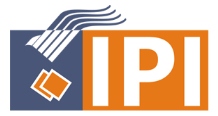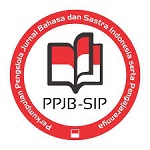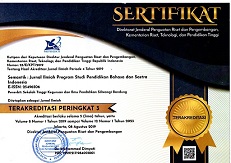ANALISIS WACANA KRITIS PERSPEKTIF KALIMAT DALAM TALK SHOW MATA NAJWA TENTANG UU OMNIBUS LAW CIPTA KERJA DI TRANS7
DOI:
https://doi.org/10.22460/semantik.v11i1.p111-124Keywords:
Sentence Perspective, Talkshow, Mata NajwaAbstract
The background of this research seen from the mass media, especially television, has become a necessity in addressing the perspectives that occur in society. Television can determine the ideology, interests and points of view to influence others. This study aims to describe Najwa Shihab's partisanship, social cognition, and context in the Mata Najwa event at Trans7 regarding the Omnibus Law: Job Creation in Trans7 Model Teun A. Van Dijk. This type of research is qualitative with a Critical Discourse Analysis (AWK) system approach. The data is in the form of speeches from the presenters in the Mata Najwa program with the concept of taking part in the host, whether to the "Pro Team" (to the government), whether to the "contra team" (to non-government) or not taking sides with both (idependent). Results Based on research and discussion, the number of sentences found in the interactive dialogue “kubu†Pro is 35 sentences. Next, the counter “stronghold†reveals 41 sentences. Based on this research, it is clear that in the program hosted by Najwa Shibab, the sentence structure used has an ideology and characteristics that are impartial, independent, and open. This means that based on the sentence issued by the speaker (the presenter) it is below 50%. This means that the media does not take sides with the government, the counter team, or others. This event purely displays polemics and events that occur in society. Meanwhile, the context of the birth of this event cannot be separated from the polemic of the Job Creation Law which has attracted public attention.ÂReferences
Ariputra, A. M., Rohmadi, M., & Sumarwati, S. (2018). Language politeness principle in indonesia lawyers club talkshow on tv one. OKARA: Jurnal Bahasa dan Sastra, 12(1), 115-124. https://doi.org/10.19105/ojbs.v12i1.1766
Ariyani, N. W. E. (2020). Pelanggaran kesantunan berbahasa dalam dialog interaktif mata najwa trans 7 episode ragu-ragu perpu. Jurnal Membaca (Bahasa dan Sastra Indonesia), 5(2), 133–144.
Arsyandikayani, A., & Sumarlam, S. (2020). Wacana opini people power, akhirnya akan mencari legitimasi kontitusional (pendekatan analisis wacana kritis van dijk). Jurnal Pendidikan Bahasa dan Sastra, 19(2), 164–172.
Badara, A. (2012). Analisis wacana: tori, metode, dan penerapan pada wacana media. Jakarta: Kencana Prenada Media Group.
Bambang. (2006). Pengantar Jurnalis Media. Yogyakarta: Pustaka Godho Suli.
Baryadi, P. (2002). Dasar-dasar analisis wacana dalam bahasa. Yogyakarta: Pustaka Godho Suli.
Brown, G. & Yule, G. (1996). Analisis wacana. Jakarta: Gramedia Pustaka Umum.
Cacciatore, M. A., Binder, A. R., Scheufele, D. A., & Shaw, B. R. (2012). Public attitudes toward biofuels. Politics and the Life Sciences, 31(1–2), 36–51. https://doi.org/10.1017/S0730938400014246
CNN Indonesia. (2020). "Detik-detik Ketok Palu RUU Ciptaker di Malam Minggu Pandemi". Retrieved from https://www.cnnindonesia.com/nasional/20201004130542-20-554163/detik-detik-ketok-palu-ruu-ciptaker-di-malam-minggu-pandemi.
Darma, Y. A. (2009). Analisis wacana kritis. Bandung: Yrama Widya.
Eriyanto. (2001). Analisis wacana: pengatar analis teks media. Yogyakarta: LKIS.
Ermanto. (2011). Kajian wacana jurnalistik: mengungkap perjuangan dan pertarungan kekuasaan. Padang: Sukabina Press.
Fairclough, N. (2003). Language and Power: Relasi Bahasa, Kekuasaan, dan Ideologi. Terjemahan Indah Rohmani. Malang: Boyan Publishing.
Lado, C. R. (2014). Analisis wacana kritis program mata najwa “Balada Perda†di MetroTV. Jurnal E-Komunikasi, 2(2). 1-12.
Mardiansyah, D., Yandi, Y., & Fitriyah, L. (2021). Dimensi teks wacana kritis model van dick dalam syair nasehat diniyah karya hasan qolay. Seulas Pinang: Jurnal Pendidikan Bahasa dan Sastra, 3(1), 20-32.
Mccargo, D. (2017). New media, new partisanship: Divided virtual politics in and beyond Thailand. International Journal of Communication, 11, 4138–4157.
Moleong, L. (2010). Metodologi penelitian kualitatif. Bandung: Remaja Rosdakarya.
Pérez-Liñán, A. (2002). Television news and political partisanship in Latin America. Political Research Quarterly, 55(3), 571–588. https://doi.org/10.1177/106591290205500304
Prajarto, N. (2004). Terorisme dan media massa: debat keterlibatan media. Jurnal Ilmu Sosial dan Ilmu Politik, 8(1), 37–52.
Rumata, V. M., & Elfrida, S. V. (2019). Ideologi dan kekuasaan pemerintah di balik wacana pembangunan tol laut: analisis wacana kritis terhadap materi siaran DBU LPP RRI Sorong, 20 Oktober 2017. Jurnal Penelitian Komunikasi dan Opini Publik, 23(2), 90-103.
Sari, I. P. (2018). Keberpihakan media dalam pemilihan presiden 2014. Jurnal Penelitian Komunikasi, 21(1), 73–86. https://doi.org/10.20422/jpk.v21i1.492
Setiowati, E., & Inayati, R. N. (2016). Framing analysis on the news of violations on ethical code by parliament chairman (case on tv talk show “metro tv-mata najwa†and “tv one–indonesian lawyer clubâ€). Journal of Education and Social Sciences, 4, 213-218.
Sudiyana, B., Widayati, M., Sudiatmi, T. (2018). Judul berita sebagai strategi kebahasaan keberpihakan media dalam perspektif protagonis. Pertemuan Ilmiah Bahasa Dan Sastra Indonesia (Pibsi), 1105-1114.
Saidi, S. M. (2016). Fungsi pelaku dalam kalimat pasif bahasa Indonesia. Paramasastra, 3(2). 209-224. https://doi.org/10.26740/parama.v3i2.1526
Setiawan, Y. B. (2011). Analisis wacana kritis pemberitaan kekerasan berbasis gender di surat kabar harian suara merdeka. Jurnal Ilmiah Komunikasi: MAKNA, 2(1), 13–20.
Suroso. (2009). Pemanfaatan analisis wacana kritis dalam bahasa pers: tinjauan teoretis. Sarasehan Forum Bahasa Media Massa (FBMM), 1(1).
Sobur, A. (2011). Analisis teks media: suatu pengantar untuk wacana, analisis semiotik, dan analisis framing. Bandung: PT Remaja Rosdakarya.
Sholekha, M., & Mulyono. (2021). Penggunaan kalimat aktif dan pasif pada novel “rindu†oleh Tere Liye kajian sintaksis. Bapala, 8(3), 135-145).
Sugiono, D (ed). (2008). Kamus besar bahasa indonesia. Jakarta: Gramedia Pustaka Utama.
Titscher, S., Mayer, M., Wodak, R., & Vetter, E. (2009). Metode analisis teks dan wacana. Yogyakarta: Pustaka Pelajar.
van Dijk, T. A. (1994). Discourse and Cognition in Society. In David Crowley & David Mitchell (ed) comunication Theory Today. Cambridge: Polity Press.
van Dijk, T. A. (2017). How globo media manipulated the impeachment of Brazilian president Dilma Rousseff. Discourse and Communication, 11(2), 199–229.
https://doi.org/10.1177/1750481317691838
Widiastuti, H., Koagouw, F. V., & Kalangi, J. S. (2018). Teknik wawancara dalam menggali informasi pada program Talk Show Mata Najwa Episode Tiga Trans 7. Jurnal Acta Diurna, 7(2), 1–5.
Zulmi, F. (2017). Keberpihakan media terhadap isu pelestarian lingkungan hidup. Jurnal Kata: Penelitian tentang Ilmu Bahasa dan Sastra, 1(2), 101-108. https://doi.org/10.22216/jk.v1i2.2138.











